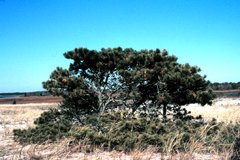Pitch Pine
|
|
| Pitch Pine | ||||||||||||||||
|---|---|---|---|---|---|---|---|---|---|---|---|---|---|---|---|---|
| | ||||||||||||||||
| Scientific classification | ||||||||||||||||
|
The Pitch Pine (Pinus rigida) is a small-to-medium sized (6-30 m) tree, often contorted due to fire or weather. This pine occasionally hybridizes with other pine species such as Loblolly Pine (P. taeda), Shortleaf Pine (P. echinata), and Pond Pine (P. serotina); the last is treated as a subspecies of Pitch Pine by some botanists.
The Pitch Pine is found mainly in the north eastern United States, from Maine and Ohio to Kentucky and northern Georgia. A few stands occur in southern Quebec and Ontario. This pine occupies a variety of habitats from dry, acidic sandy uplands to swampy lowlands, and can survive in very poor conditions; it is the primary tree of the New Jersey Pine Barrens.
Pinus_rigida.JPG
The needles are in fascicles of three, about 6-13 cm in length, and are stout (over 1 mm broad) and often slightly twisted. The cones are 4-7 cm long and oval with prickles on the scales. The species is unusual in often having shoots sprouting directly from the trunk. This is an adaptation to fire, enabling trees to re-sprout after fire has killed the crown; the thick bark protects the trunk from damage unless the fire is very severe. Burnt trees often form stunted, twisted trees with multiple trunks as a result of the resprouting.
The Pitch Pine is not a major timber tree, due to the frequency of multiple or crooked trunks; nor is it as fast-growing as other eastern American pines. However it grows well on unfavourable sites. In the past, it was a major source of timber for ship building, mine timbers, and railroad ties, because the wood's high resin content preserves it from decay. Nowadays Pitch Pine is used mainly for rough construction, pulp, crating, and fuel.pl:Sosna smołowa

